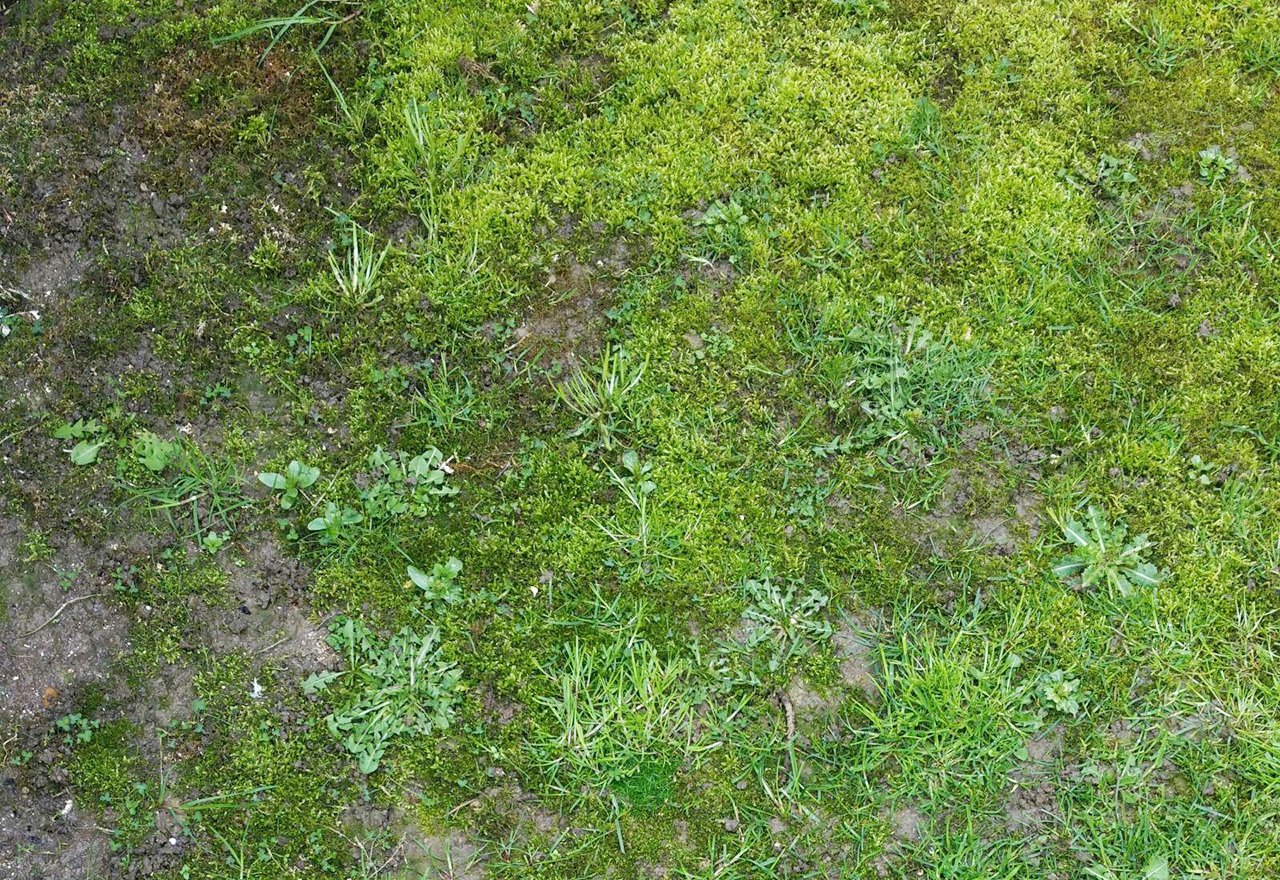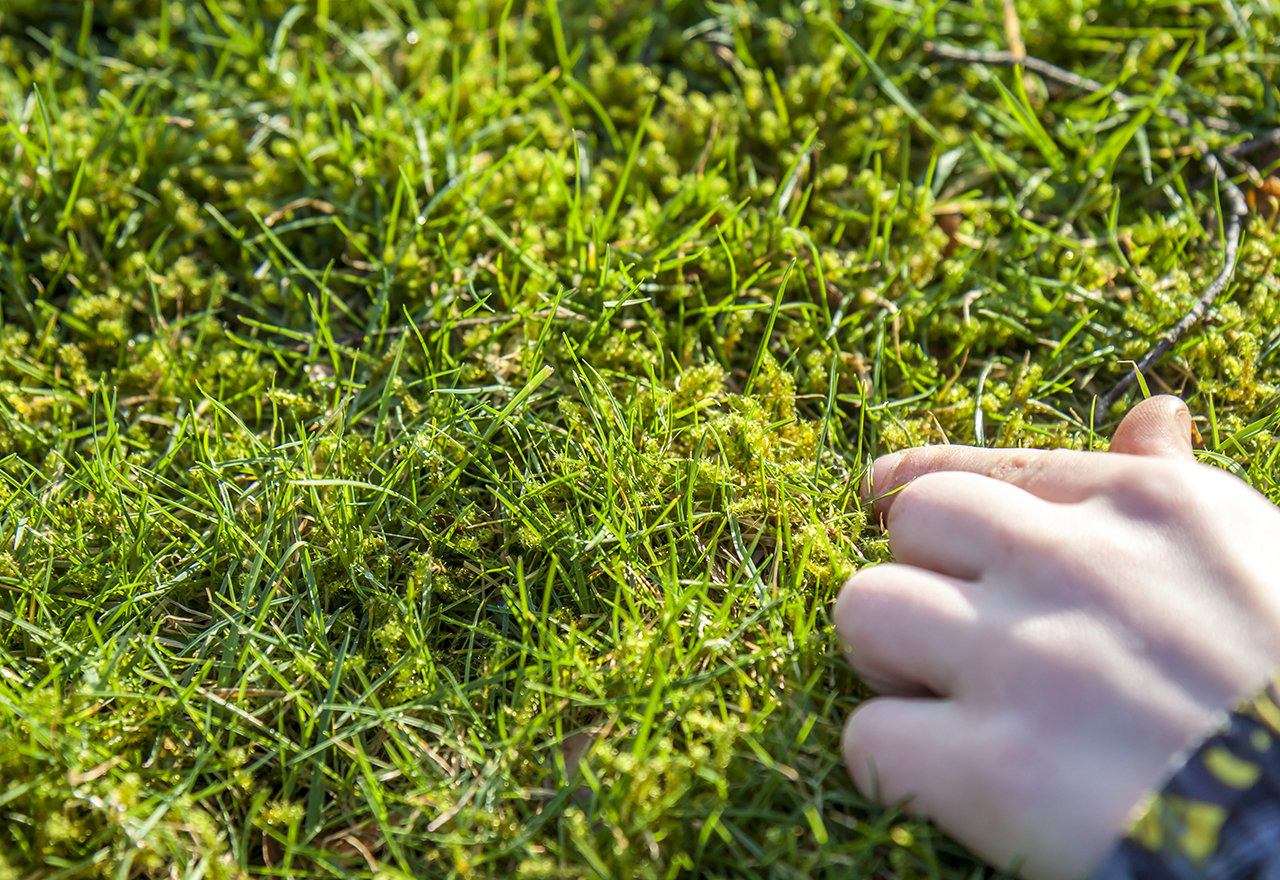Moss Prospers in Damp, Shady Areas, Where Grass Struggles to Grow

There are many varieties of mosses that grow in the Midwest but we are going to just “clump” them all together for the purpose of this conversation. Mosses are generally low-growing, herbaceous (non-woody), flowerless, non-vascular (no xylem or phloem system) plants. They do not propagate via seeds, but use spores thrown to the wind to spread. They also spread via root-like rhizoids underground. If you get down really close to moss, you will see that the plant actually has leaves and branches but they grow so close together that moss usually just looks like a large mat or tuft. The rhizoids or roots are very shallow.
Moss typically prospers where grass has a difficult time growing. Damp, shady areas are ideal for most moss growth. Moss also thrives in lawns that have compacted soil, poor quality soil, poor drainage, weak and thin grass, or imbalanced pH (usually too low, but also sometimes too high).
The easiest way to get rid of moss is to rake it up with a metal rake. Mosses do not have deep roots and are easy to pull up this way. There are also natural products that will kill moss, including vinegar. However, don’t remove moss before you resolve the problem that attracted the moss in the first place. You need to make conditions more conducive for grass growth instead of moss.
We recommend getting your soil test to start. We offer a Soil Analysis or you can often get a test through your local university extension office. We use Brookside Laboratories, which was founded by the father of organic agriculture, William Albrecht. From any soil test though, you will determine the status of your property’s soil. If you have low organic matter, we might recommend Compost Topdressing. If you have low nutrients, we’ll recommend specific nutrient supplementation for what you are lacking.
In addition to a soil test, determine if your soil is compacted. Healthy soil has 50% open spaces, which hold air and water that grass needs to survive. Compacted soil might only have 10% open space, severely stressing grass roots. If water puddles in your lawn regularly, your soil is compacted. To reduce the compaction of your soil, we recommend a physical Core Aeration in the Fall annually. Using Liquid Aeration in the Spring and Summer will also help loosen the soil. Both of these forms of aeration will invite beneficial organisms such as worms, insects, and nematodes, which will add to the health of your soil. Additionally, more open space will also encourage the roots of your grass to grow deeper, making it stronger.
Shade is also a big reason why moss might be thriving on your lawn. Changing up a solid fence to one that will allow more sunlight through may help. Also, consider thinning tree branches that stretch over your moss problem area. If your yard is shady and you don’t want to get rid of that shade, we certainly understand. When you get rid of your mossy lawn area, evaluate if grass really is the best replacement. Instead, consider a shade garden, a patio, or gravel – these might be better placed in this spot on your property than grass.
Once you have these issues cleared up, remove your moss and reseed the area with grass specific for your lawn. For our Midwest region, we like to use a seed mixture of 5% Microclover, 90% Turf Type Tall Fescue, and 5% Kentucky Bluegrass. We sell a pre-made mix: our Tuff Turf Lawn Seed with these ratios of Turf Type Tall Fescue and Kentucky Bluegrass and we also sell bags of Microclover in our online shop.
We have some tried and true healthy lawn recommendations that will keep your grass strong so that moss doesn't move in where your grass is thin.
There are a few mowing practices we encourage the most. We encourage our organic lawn care customers to avoid trying to match their neighbor’s lawn length. Healthy grass relies on deep roots, and short grass does not have deep roots. So we want you to mow higher than your neighbors: 3.5 – 4.5 inches. Additionally, sharpen your mower blades annually to be sure they aren’t harming the individual grass blades. If you see ragged tips on your grass blades, sharpen your mower blades! And don’t bag your grass clippings – let them lay on your lawn to break down and fertilize the soil.
We also like to add a bit of Microclover to yards. We have a variety in our online shop that is small and doesn’t flower. Clover is a legume and so will add nitrogen to your soil, which will feed your grass – fertilizing it without any work! Clover’s bright green hue will last the entire Summer, even when grass sometimes goes “golden” in the heat of the season.
For fertilizing lawns, we have in-house products specific to Spring and Fall. We recommend a double dose in the Spring (one around Easter and the other around Memorial Day) and two more in the Fall (one around Labor Day and the second around Halloween).
Mosses are frequently used in flower arrangements or as an agent to soak up liquid because they can absorb up to 20 times their weight. Moss is also a component of commercial peat used to mix into garden and houseplant soil. You can use moss in these same ways around your home: add it to floral displays, soak up spills outside, and chop it up and bury it in your gardens.
Many people get lichen, liverworts, and moss confused. Both liverworts and moss produce via spores and do not have vascular systems. Liverworts are mostly found in the tropics, while moss is found throughout the world. Liverworts have more distinct lobes that are called a thallus, while the branches of moss are not always clear. Both moss and lichen break down anything they grow on. Lichenes are not plants at all, but actually a symbiotic relationship between algae and fungi.
